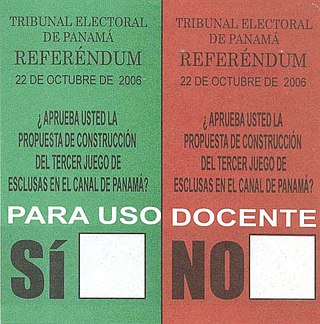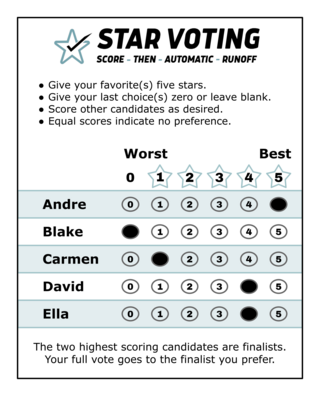
Approval voting is an electoral system in which voters can select any number of candidates instead of selecting only one.
Plurality voting refers to electoral systems in which a candidate in an electoral district who polls more than any other is elected. Used for elections of representative bodies, it competes with the proportional representation. In systems based on single-member districts, the plurality system elects just one member per district and is then frequently called a "first-past-the-post" (FPTP), sometimes "single-member [district] plurality" (SMP/SMDP). A system that elects multiple winners elected at once with the plurality rule and where each voter casts multiple X votes in a multi-seat district is referred to as plurality block voting. A semi-proportional system that elects multiple winners elected at once with the plurality rule and where each voter casts just one vote in a multi-seat district is known as single non-transferable voting.
Score voting, sometimes called range voting or average score voting, is an electoral system for single-seat elections. Voters give each candidate a numerical score, and the candidate with the highest average score is elected. Score voting includes the well-known approval voting, but also lets voters give partial (in-between) approval ratings to candidates.

The two-round system (TRS), also known as runoff voting, second ballot, or ballotage, is a voting method used to elect a single candidate. The first round is held using simple plurality to choose the top-two candidates, and then in the second round the winner is chosen by majority vote. The two-round system is widely used in the election of legislative bodies and directly elected presidents.

The single transferable vote (STV), sometimes known as proportional ranked choice voting (P-RCV), is a multi-winner electoral system in which each voter casts a single vote in the form of a ranked-choice ballot. Voters have the option to rank candidates, and their vote may be transferred according to alternate preferences if their preferred candidate is eliminated or elected with surplus votes, so that their vote is used to elect someone they prefer over others in the running. STV aims to approach proportional representation based on votes cast in the district where it is used, so that each vote is worth about the same as another.
Strategic or tactical voting is a situation where a voter considers the possible ballots cast by other voters in order to maximize their satisfaction with the election's results. For example, in plurality or instant-runoff, a voter may recognize their favorite candidate is unlikely to win and so instead support a candidate they think is more likely to win.

A Condorcet method is an election method that elects the candidate who wins a majority of the vote in every head-to-head election against each of the other candidates, whenever there is such a candidate. A candidate with this property, the pairwise champion or beats-all winner, is formally called the Condorcet winner. The head-to-head elections need not be done separately; a voter's choice within any given pair can be determined from the ranking.

Voting is a method by which a group, such as a meeting or an electorate, convenes together for the purpose of making a collective decision or expressing an opinion usually following discussions, debates or election campaigns. Democracies elect holders of high office by voting. Residents of a jurisdiction represented by an elected official are called "constituents", and the constituents who choose to cast a ballot for their chosen candidate are called "voters." There are different systems for collecting votes, but while many of the systems used in decision-making can also be used as electoral systems, any which cater to proportional representation can only be used in elections.
Cumulative voting is a multiple-winner method intended to promote more proportional representation than winner-take-all elections such as block voting or first past the post. Cumulative voting is used frequently in corporate governance, where it is mandated by some (7) U.S. states.
Bucklin voting is a class of voting methods that can be used for single-member and multi-member districts. As in highest median rules like the majority judgment, the Bucklin winner will be one of the candidates with the highest median ranking or rating. It is named after its original promoter, the Georgist politician James W. Bucklin of Grand Junction, Colorado, and is also known as the Grand Junction system.
The majority criterion is a voting system criterion. The criterion states that "if only one candidate is ranked first by a majority of voters, then that candidate must win."
Later-no-harm is a property of some ranked-choice voting systems, first described by Douglas Woodall. In later-no-harm systems, modifying the rating or rank of a candidate ranked below the winner of an election cannot change the result.
In voting systems theory, the independence of clones criterion measures an election method's robustness to strategic nomination. Nicolaus Tideman was the first to formulate this criterion, which states that the winner must not change due to the addition of a non-winning candidate who is similar to a candidate already present. It is a relative criterion: it states how changing an election should or shouldn't affect the outcome.
There are a number of complications and issues surrounding the application and use of single transferable vote proportional representation that form the basis of discussions between its advocates and detractors.
The Borda count is a family of positional voting rules which gives each candidate, for each ballot, a number of points corresponding to the number of candidates ranked lower. In the original variant, the lowest-ranked candidate gets 0 points, the next-lowest gets 1 point, etc., and the highest-ranked candidate gets n − 1 points, where n is the number of candidates. Once all votes have been counted, the option or candidate with the most points is the winner. The Borda count is intended to elect broadly acceptable options or candidates, rather than those preferred by a majority, and so is often described as a consensus-based voting system rather than a majoritarian one.
Instant-runoff voting (IRV), also known as plurality with elimination or plurality loser, is a ranked-choice voting system that modifies plurality by repeatedly eliminating the last-place winner until only one candidate is left. In the United Kingdom, it is generally called the alternative vote (AV). In the United States, IRV is often conflated with ranked-choice voting (RCV); however, this conflation is not completely standard, and social choice theorists tend to prefer more explicit terms.
The later-no-help criterion is a voting system criterion formulated by Douglas Woodall. The criterion is satisfied if, in any election, a voter giving an additional ranking or positive rating to a less-preferred candidate can not cause a more-preferred candidate to win. Voting systems that fail the later-no-help criterion are vulnerable to the tactical voting strategy called mischief voting, which can deny victory to a sincere Condorcet winner.
A major branch of social choice theory is devoted to the comparison of electoral systems, otherwise known as social choice functions. Viewed from the perspective of political science, electoral systems are rules for conducting elections and determining winners from the ballots cast. From the perspective of economics, mathematics, and philosophy, a social choice function is a mathematical function that determines how a society should make choices, given a collection of individual preferences.

STAR voting is an electoral system for single-seat elections. The name stands for "Score then Automatic Runoff", referring to the fact that this system is a combination of score voting, to pick two finalists with the highest total scores, followed by an "automatic runoff" in which the finalist who is preferred on more ballots wins. It is a type of cardinal voting electoral system.
Descending Solid Coalitions (DSC) is a ranked-choice voting system. It is designed to preserve the advantages of instant-runoff voting, while satisfying monotonicity. It was developed by voting theorist Douglas Woodall as an improvement on (and replacement for) the use of the alternative vote.







